Key takeaways:
- Water flow in rivers is influenced by natural elements such as gradient, volume, and human activities, impacting ecosystems and communities.
- Hydro energy production converts the kinetic energy from flowing water into electricity, emphasizing the need for a balance between energy generation and ecological preservation.
- Diverse methods of harnessing river energy include hydroelectric dams, small-scale run-of-river systems, and tidal energy, each with varying ecological impacts.
- Future hydro energy development relies on optimizing existing infrastructure, community engagement, and innovative technologies to enhance sustainability and energy efficiency.
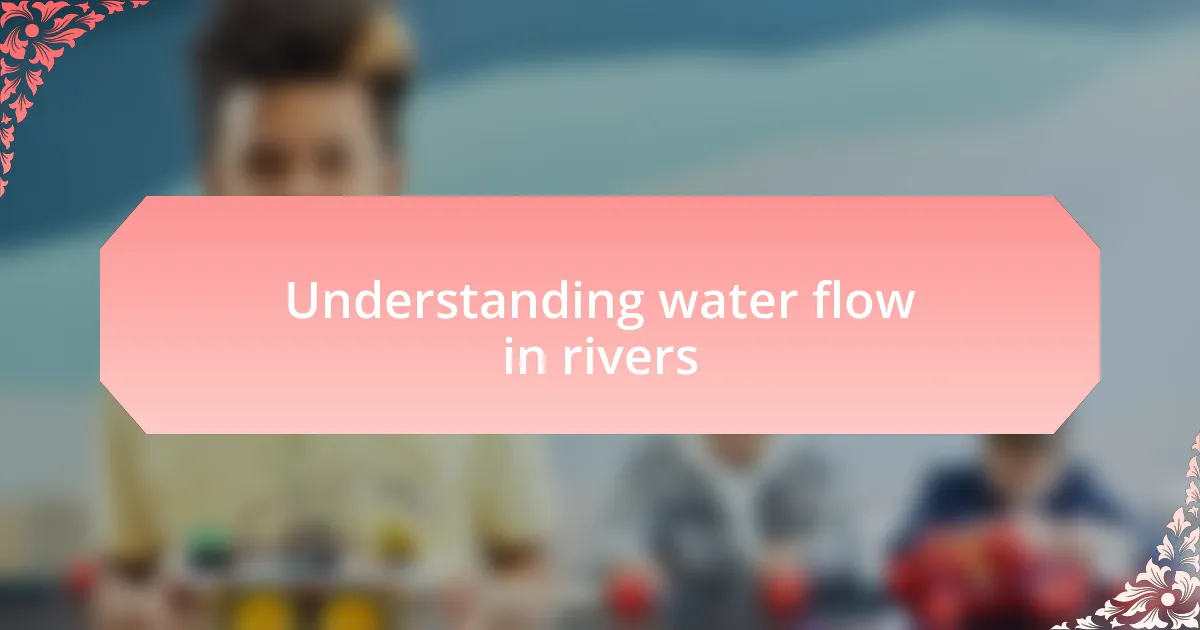
Understanding water flow in rivers
Water flow in rivers is a fascinating dance of nature that combines numerous elements like gradient, volume, and landform. I often find myself wondering how these rivers carve their paths through landscapes, creating not just valleys but also ecosystems that thrive alongside them. It’s amazing to think about the sheer force behind even a gentle stream, shaped by gravity and the terrain it encounters.
As a child, I spent countless afternoons by the riverbank, mesmerized by the ripples and currents. Each movement seemed purposeful, as if the water was telling a story of its journey from the mountains to the sea. It struck me then how vital this flow is—not just for the river itself, but for the flora and fauna that rely on it. How do they adapt to the changing conditions of flow? This aspect is often overlooked, yet it reveals so much about resilience in nature.
Understanding water flow isn’t merely about physics; it involves appreciating the interconnectedness of all living things. The speed and volume of river water can vary dramatically due to seasonal changes, rainfall, or human interference, prompting us to consider our role in this intricate web. Isn’t it thought-provoking to realize that every drop contributes to a larger narrative, impacting communities and ecosystems alike?
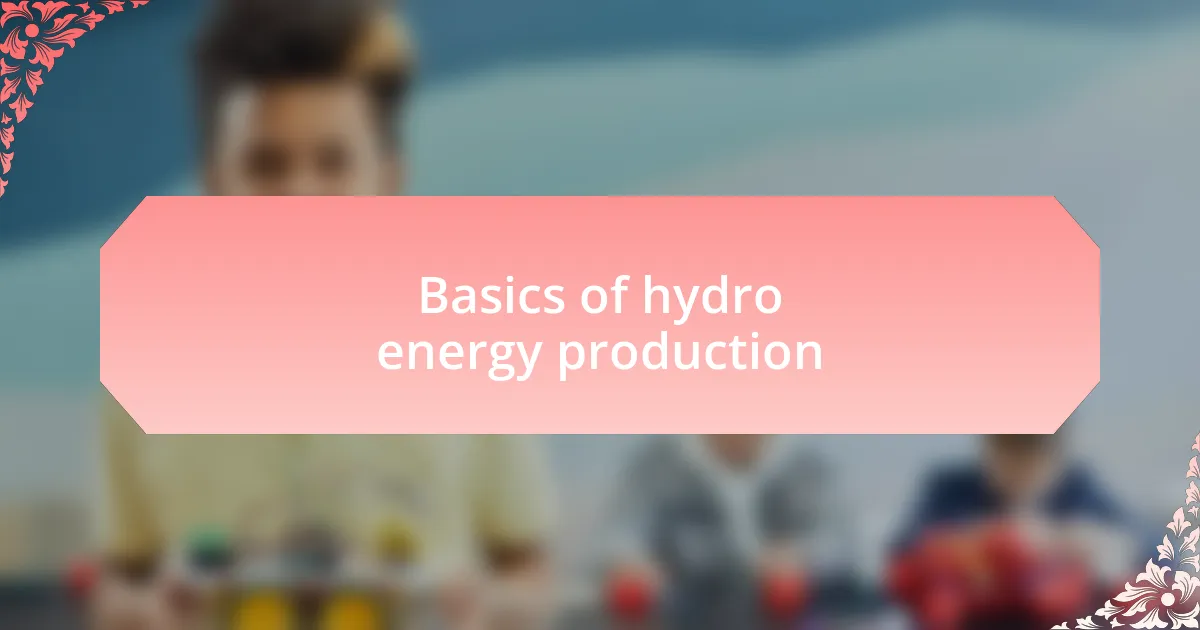
Basics of hydro energy production
Hydro energy production harnesses the kinetic energy of flowing water, converting it into electricity. It’s remarkable to me how the movement of water, whether from a river or a dam, can power homes and industries. I’ve often marveled at hydroelectric plants, standing tall by rivers, quietly transforming the relentless flow into usable energy.
The basics of this process involve a few key components: a water source, a turbine, and a generator. When water flows over the turbine blades, it spins them, which then drives the generator to produce electricity. I remember visiting a hydroelectric facility, where I gained firsthand insight into just how significant every drop is in this production chain. Isn’t it incredible to think that a simple waterfall can produce enough power to illuminate thousands of homes?
Moreover, hydro energy is considered a renewable source, making it a sustainable choice compared to fossil fuels. But, I can’t help but reflect on the balance we need to maintain. We must ensure that while we maximize energy production, we also preserve the natural ecosystems that depend on consistent water flow. How do we strike that balance? Navigating this question is crucial as we explore the potential of hydro energy in our quest for a greener future.

Factors affecting river flow
River flow is influenced by several factors, notably rainfall and snowmelt. I recall a summer trip to a river that had a notoriously strong current during the rainy season but was barely a trickle in the dry months. It made me appreciate how precipitation patterns directly alter river dynamics. Isn’t it fascinating how something as simple as weather can dramatically reshape our waterways?
Additionally, human activities can significantly impact river flow. Dams and water withdrawal for agriculture have become common practice, often leading to drastic changes in water levels. I remember standing by a river where construction had diverted its course, and it felt surreal to see a once-thriving ecosystem shift into something unrecognizable. It begs the question: are we prioritizing immediate benefits over the long-term health of our rivers?
Moreover, geography plays a critical role in determining how water flows through a river system. Variables such as elevation, soil composition, and natural obstructions—all of these can create diverse flow conditions. For example, the swift waters of a mountain stream are undeniably captivating, but they differ dramatically from the gentle meanders of a lowland river. Have you ever experienced the thrilling speed of a rapid? Those differences reveal the unique identities of each river and remind us that every waterway has its own story to tell.
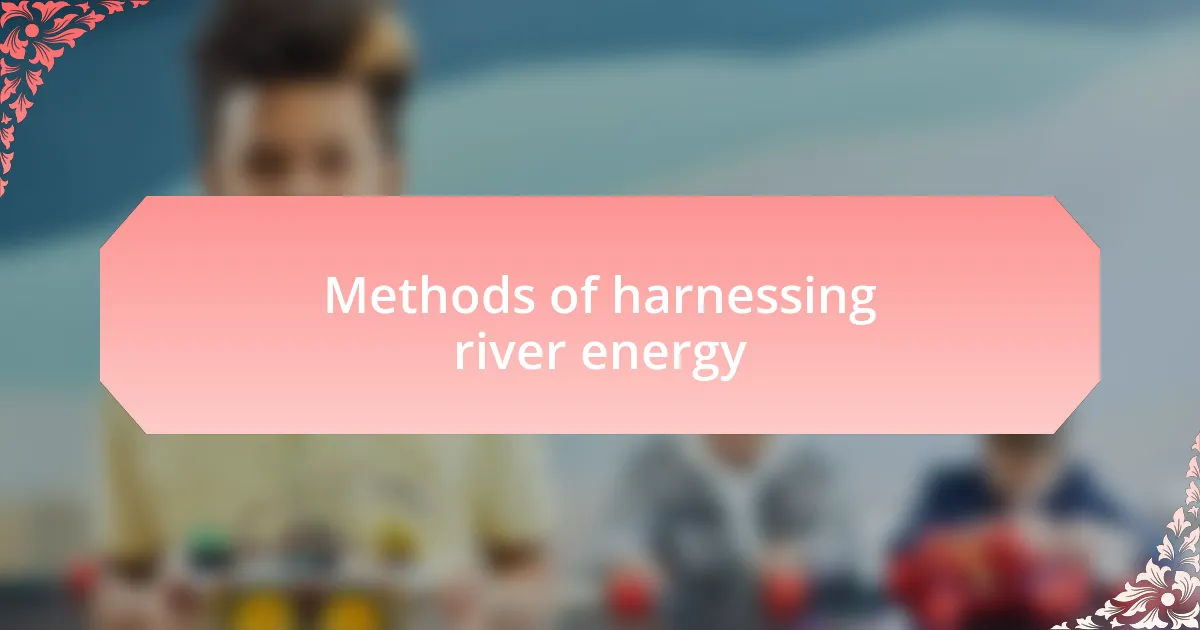
Methods of harnessing river energy
Harnessing river energy can be accomplished through various methods, each with its own unique benefits and challenges. One of the most common techniques is the use of hydroelectric dams, which convert the kinetic energy of flowing water into electricity. During a river rafting adventure, I marveled at how the force of the rushing water could be transformed into power, illustrating just how dynamic our natural resources can be. Have you ever thought about the immense energy that flows beneath a dam’s surface, quietly working to generate electricity for our cities?
Another intriguing method is the installation of small-scale run-of-river systems, which generate energy without creating significant reservoirs. These systems preserve the natural flow and ecology of the river, something I truly appreciate after spending an afternoon fishing in a tranquil stretch of water. It’s remarkable how technology can adapt to the environment while still producing clean energy. Wouldn’t it be great if we could harness power while maintaining the natural beauty of our waterways?
Tidal energy is another innovative approach that remains intertwined with river dynamics, where turbines capture the movement of water caused by tides. Reflecting on visits to coastal rivers, I often found myself captivated by the rhythm of the tides. The ebb and flow resemble a natural clockwork that can be harnessed for energy. Isn’t it inspiring to think that the very forces of nature, like the tides, can be utilized sustainably?
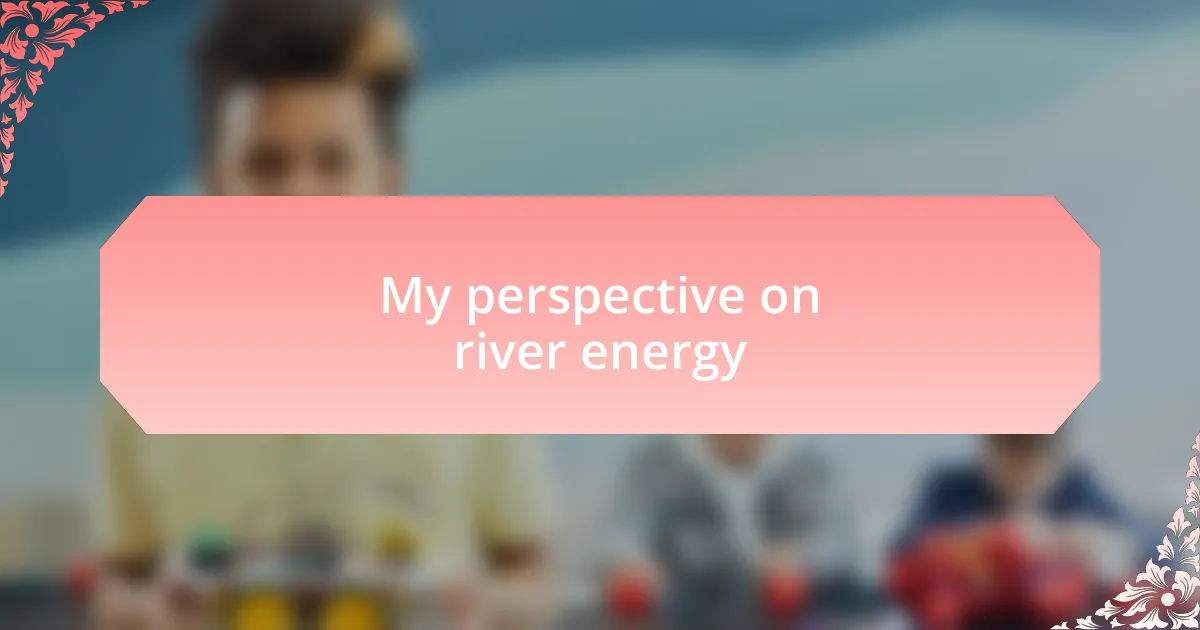
My perspective on river energy
My perspective on river energy is rooted in a deep appreciation for the intricate relationship between nature and technology. I remember a weekend spent canoeing on a winding river, where I felt the gentle push of the current guiding my boat. It struck me that this same water, as it flows unrestrained, holds the potential to generate electricity. How extraordinary is it that something so beautiful can also power our homes and lives?
I often reflect on the balance between harnessing river energy and preserving our aquatic ecosystems. One summer, I volunteered for a river cleanup and witnessed firsthand the delicate network of life that thrives in these waters. It made me wonder: how can we responsibly tap into this energy without disrupting the habitats of countless species? I believe that sustainable practices are essential, ensuring we respect the flow of life as we seek to benefit from the flow of water.
In my travels, I have seen both the stunning potential and the significant challenges of using river energy. On one trip through a mountainous region, I hiked alongside a river that cascaded down rocks, creating a mesmerizing torrent. It left me questioning the future of such natural wonders in the face of industrial energy demands. Is our pursuit of energy worth risking the purity of these breathtaking landscapes? I firmly believe we can harness river energy while still cherishing the natural beauty that inspired it.
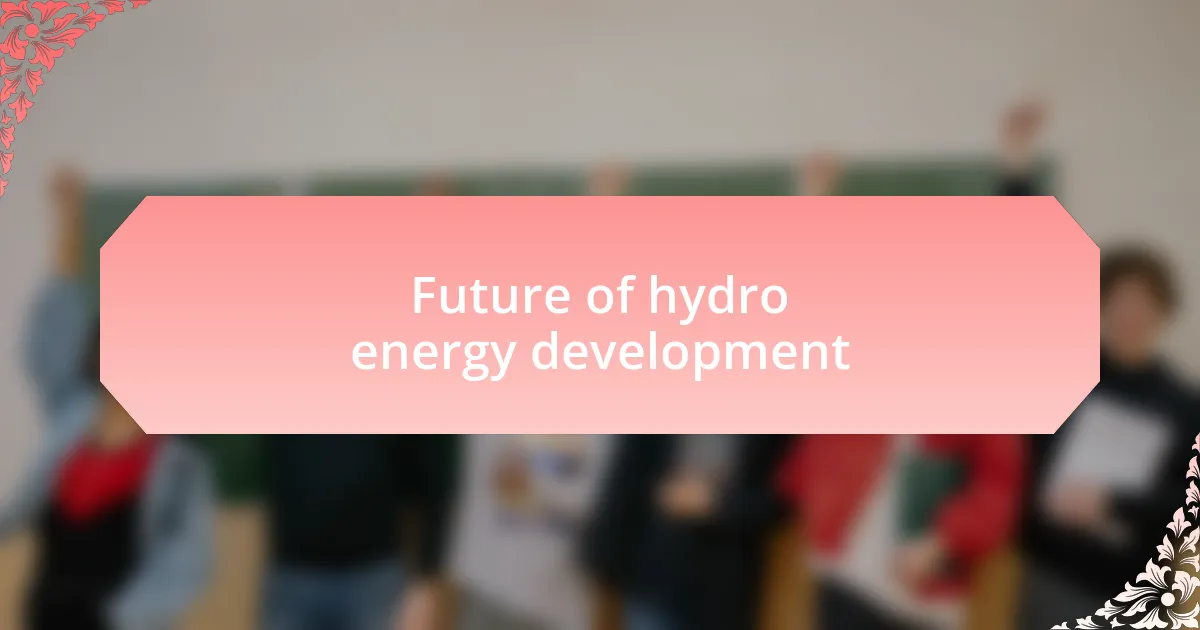
Future of hydro energy development
As I think about the future of hydro energy development, I can’t help but recall a visit to a small hydropower facility nestled in the hills. Standing beside the serene reservoir, I realized how advancements in turbine design could allow us to generate even more energy without increasing our environmental footprint. Could this be the turning point where innovation meets sustainability, propelling us toward a cleaner energy future?
In my view, optimizing existing infrastructures presents a tremendous opportunity. I remember chatting with an engineer who had implemented a re-watered river system that improved energy efficiency while enhancing fish passage. It made me ponder: why aren’t we investing more in retrofitting aged dams and using smart technology to boost performance? This approach not only supports energy production but also restores the health of our ecosystems.
Looking ahead, I am inspired by community engagement in hydro projects. I recently attended a local town hall meeting where residents voiced their ideas for small-scale hydro initiatives. Their enthusiasm was contagious! It reinforced my belief that when communities champion hydro energy, we can foster innovation, create jobs, and boost local economies—all while nurturing our important water resources. Isn’t it exciting to think about the potential when collaboration becomes part of the energy equation?